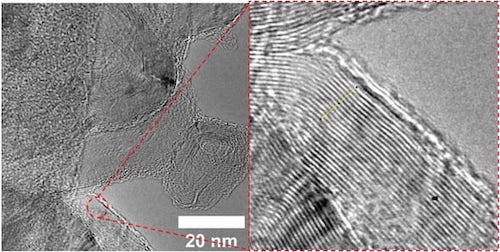TUESDAY, APRIL 6, 2021
Researchers at Rice University are continuing their work on graphene, recently saying that they have optimized a process to convert waste from rubber tires into graphene that can then be used to strengthen concrete.
While it is acknowledged that recycled tire waste is already used in Portland cement, the Rice researchers note that graphene itself has been proven to strengthen cementitious materials at the molecular level.
To recover the graphene from the tires, the researchers are using a “flash” process that they introduced in 2020. The process exposes material to a jolt of electricity that removes everything but the carbon atoms. Those atoms then reassemble into turbostratic graphene, which is more soluble that graphene produced from graphite and therefore easier to use in composite materials.

 |
| Rice University |
|
Researchers at Rice University are continuing their work on graphene, recently saying that they have optimized a process to convert waste from rubber tires into graphene that can then be used to strengthen concrete. |
According to Rice, the lab flashed tire-derived carbon black and found about 70% of the material converted to graphene. When flashing shredded rubber tires mixed with plain carbon black to add conductivity, about 47% converted to graphene. (Elements besides carbon were vented out for other uses.)
For the actual process, the electrical pulses lasted between 300 milliseconds and one second. The lab calculated that the electricity used in the conversion process costs about $100 per ton of starting carbon.
The researchers then blended minute amounts of tire-derived graphene—0.1 weight/percent (wt%) for tire carbon black and 0.05 wt% for carbon black and shredded tires—with Portland cement and used it to produce concrete cylinders.
After curing for seven days, the cylinders showed gains of 30% or more in compressive strength. After 28 days, 0.1 wt% of graphene sufficed to give both products a strength gain of at least 30%.
Rice graduate student Paul Advincula is lead author of the paper on this research that recently appeared in Carbon. Co-authors are Rice postdoctoral researcher Duy Luong and graduate student Weiyin Chen, and Shivaranjan Raghuraman of C-Crete. Chemist James Tour is the T.T. and W.F. Chao Chair in Chemistry as well as a professor of computer science and of materials science and nanoengineering at Rice.
The Air Force Office of Scientific Research and the Department of Energy’s National Energy Technology Laboratory supported the research.
Past Graphene Research at Rice
In November 2018, researchers based out of Rice reported that they had built a "better" epoxy with the assistance of graphene foam.
The researchers said that when the epoxy combined with the foam—created in the university lab of Tour—it is substantially tougher than pure epoxy and more conductive than other epoxy composites.
“By itself, epoxy is an insulator, and is commonly used in coatings, adhesives, electronics, industrial tooling and structural composites," the university explained. “Metal or carbon fillers are often added for applications where conductivity is desired, like electromagnetic shielding.
“But there's a trade-off: More filler brings better conductivity at the cost of weight and compressive strength, and the composite becomes harder to process.”
What researchers did, then, was replace the metal or carbon fillers with a 3D foam made of nanoscale sheets of graphene. The lab also mixed multiwalled carbon nanotubes into the graphene foam, which acted as reinforcement bars for the graphene.
More recently, near the end of last year, the researchers announced the aforementioned flash process—initially created to make graphene out of recycled plastic—calling the process “ACDC.”
Tagged categories: Cement; Cementitious; concrete; Good Technical Practice; Graphene; Research and development